Discovering Saltburn's rich heritage and varied history.
Alpha Place
In 1863 the cliff tops overlooking the old fisher cottages of Saltburn were mostly given over to pasture, with some crops of oats, beans, clover and turnips also being grown in rotation. On a cold January morning of that same year everything was to change as one Victorian entrepreneurs dream to turn a smuggler's hideaway - 'a row of dirty derelict cottages whose broken and musty windows, like blind eyes, stare cheerlessly out to sea' - into a prestigious seaside resort, was about to be realised.
The Foundation Stone is Laid.
On a cold January morning in 1861 a small group of individuals gathered together on the clifftop overlooking the old fishing hamlet of Saltburn.
"There were not more than a dozen persons present, including our reporter and the bricklayers and bricklayers' 'paddies' "
Darlington & Stockton Times.
At the centre of this group was one Henry Pease, of Stanhope Castle and Pierremont, in Darlington, the youngest son of Edward "father of the railways" Pease. Surrounded by two Darlington architects, two Cleveland builders and their bricklayers, Henry Pease laid the foundation stone and the building of Saltburn's first street, named Alpha Place, was begun.
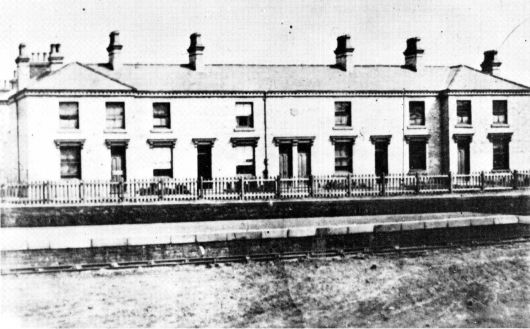
It had been agreed to run the railway to the rear of the Zetland Hotel, to be built on a pre-eminent site overlooking the bay. This effectively split the future town and Milton and Dundas Streets were laid out on either side of the railway.
Alpha Place, a block of white bricked terraced houses, was situated alongside the railway with its front facing what became the railway excursion platform and its rear across the ends of Ruby and Garnet Streets, and was erected by the S & D Railway to house their employees. The Saltburn and Guisbro' Times (4th May 1901) states that William Peachy, architect, laid the first brick two months before the formal ceremony on 23rd January 1861, when Henry Pease layed the official foundation stone. As the town had neither a station nor Post Office when the street was complete the two houses at the east of Alpha Place were used until permanent buildings became available, Mr Arthur Brown being both Stationmaster and Postmaster.
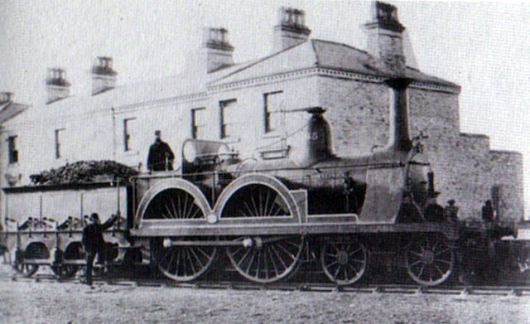
At the beginning of the 1900's the local council wished to purchase Alpha Place from the NE Railway Company for demolition as its situation prevented the development of Milton Street as a main thoroughfare. Discussions had taken place in 1896 but a high asking price meant that the idea was vetoed. By 1901 the original figure of £1650 was dropped to £1360. The council bought it and demolition took place in November. It can be determined where Alpha Place stood, as the block between Garnet and Ruby Streets is the only one with an alley actually meeting Milton Street.
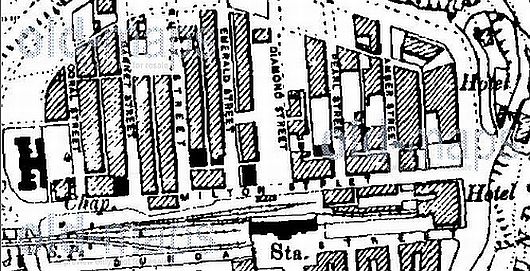
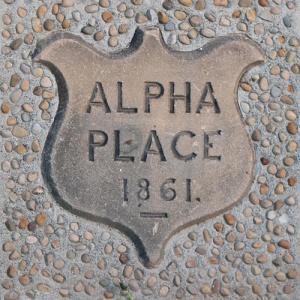 In 1935, when the Assembly Rooms were being extended to form the Spa Pavilion, the foundation plaque of Alpha Place was discovered amongst rubble on the site and was placed in the offices of the Saltburn and Marske Urban District Council in Albion Terrace. It was later built into the wall of Marine Court together with its own foundation stone which was laid by Sir Alfred Pease in 1961, the town's centenary year.
In 1935, when the Assembly Rooms were being extended to form the Spa Pavilion, the foundation plaque of Alpha Place was discovered amongst rubble on the site and was placed in the offices of the Saltburn and Marske Urban District Council in Albion Terrace. It was later built into the wall of Marine Court together with its own foundation stone which was laid by Sir Alfred Pease in 1961, the town's centenary year.
Report from the Darlington and Stockton Times January 1861
"Saltburn at no very remote period will doubtless be a fashionable watering place. Perhaps we should be charged with stretching were we to express our conviction that some day or other it will be little inferior to Scarborough. Should our anticipations never be realised, we shall blame the want of speculation. We would advise any one who laughs at our large idea to make a practical survey of the coast line north-eastward from Huntcliffe point, and if he fails to notice the majesty of the immense cliffs, or the beauty of the woodland scenery on either bank of the gills, or the excellence of the sands firm and level, long and broad; or the variety of climate, in the glens mild and warm, or the table-land cold and bracing if he fails to perceive these and a hundred other natural advantages, then we shall say he's blind – blind as a bat. But we shall refer to the subject more fully some other time. Our only object in introducing it now is merely to chronicle an event, small in itself, but pregnant with great results, which took place on Wednesday last the laying of a foundation stone, by H. Pease Esq MP. The railway extension from Redcar to Saltburn, for the construction of which Parliamentary powers were obtained in the Session of 1858, is rapidly progressing, and the permanent way will soon be complete. A few houses – about half a dozen – are being built at the terminus, within a score yards of where the station will be erected, they are the first buildings commenced to be erected. Mr Pease not despising the day of small things, went down on Wednesday afternoon to lay the foundation stone of these houses in reality, but of a large busy place in imagination. There were not more than a dozen persons present, including our reporter and the bricklayers and bricklayers "paddies". Mr John Ross (Richardson and Ross, builders, of this town) attended to witness the ceremony, so did Mr Peachey, of the engineer's department of the Stockton and Darlington Railway. Besides these there were Mr Chapman of Middlesbrough, and Mr Pearson, of Coatham, builders, and a young man with whose name or calling we were unacquainted. After spreading the mortar which Mr Pease did in a real workmanlike manner - none of your silver-trowel style - he lowered the stone, from eight to ten stones in weight, by his own muscular strength, without any mechanical assistance in the shape of rope and pulley. The work of adjusting the stone with plumb-line or square was not performed - perhaps it was overlooked. Mr Pease merely remarked after the ceremony that this was only the commencement of what would probably hereafter be the resort of those persons who were in the happy position that they could spend the summer months at the sea-side, to inhale the sea-air or enjoy themselves in rational amusements. Although the beginning was only on a moderate scale, he had little doubt but that some who were present, who were younger than himself, would live to see things on a much larger scale. He did not come there to make a long speech, but just to evince by his presence his belief that the peculiar attractions of the place would ensure its future prosperity. Three cheers were raised in order to dispel the tameness of the proceedings, which terminated by Mr Pease paying his footing."
Darlington and Stockton Times, Wednesday 23rd January 1861
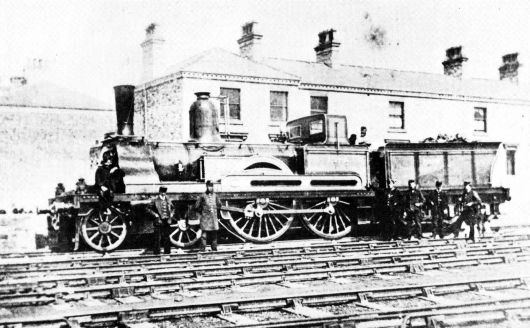
Commemorative memorial for Alpha Place
Local Historian Tony Lynn, supported by Callum Duff, initiated the process of designing and building a permanent memorial to Saltburn's first houses at Alpha Place. The memorial and plaque used reclaimed materials and the structure is faced with white Pease bricks. The plaque was unveiled in August 2012 and is sited on the north side of Sainsbury's car park.
The Saltburn by the Sea Galop
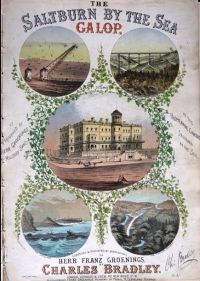 As performed by Herr Franz Groening's Military Band at the Promenade Concert, Saltburn by the Sea
As performed by Herr Franz Groening's Military Band at the Promenade Concert, Saltburn by the Sea
This piece of music was written for Saltburn in 1876 and has probably not been performed since. Written for the piano, the sheet music was owned by the late Brian Kennedy and may be the only copy still in existence.
In dance, the galop, named after the fastest running gait of a horse (see gallop), a shortened version of the original term galoppade, is a lively country dance, introduced in the late 1820s to Parisian society by the Duchesse de Berry and popular in Vienna, Berlin and London.The galop was a forerunner of the polka and was particularly popular as the final dance of the evening.
Research by Rebecca Hilton. Collecting primary source materials, articles and extracts from books related to the development of both Saltburns and trying to validate them has offered conflicting information, much of which is often difficult to validate as many sources can prove to be unreliable e.g. newspapers or census data. Every effort has been made to ensure that the information on the history of the town presented here is as accurate as possible.
